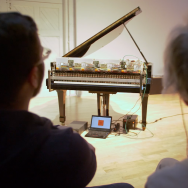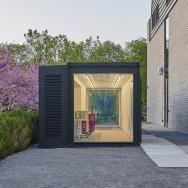A fiberglass grid scattered with flower petals. A galvanized steel rod, partially taken over by a tree. A playfully ornate pot that seems to be talking.
That’s because it is.
Inside Harold Mendez: the years now, on display at the University of Chicago’s Logan Center for the Arts, is a funerary pot of the Chimú people from the Moche Valley in Peru. Well, almost.
Scaled up and hollowed out to accommodate a speaker system, the vessel is a 3D-printed replica of the original piece of pre-Columbian pottery, which sits safe and sound in a temperature-controlled section of the Field Museum. Rendering haunting dialogue, the replicated ancient pot is a captivating piece of art—the product of an exciting first-time collaboration between the Field and the Logan Center.
Why would a venerable institution like the Field use technology more often associated with maker spaces? Turns out, 3D scanning is incredibly helpful in archaeology, offering a way for exhibitions to balance preservation with public access.
“When you get a million people a year through a gallery, the touching can be quite destructive,” said Field Museum conservator JP Brown, a UChicago alum. “So in general, we’re extremely reluctant to put original items in direct contact with the public.”
Brown, SM’05, has used 3D scanning before as a conservator for the Field’s Department of Anthropology—deploying a CT scanner on everything from instruments to effigy figures to mummies. That work helped make possible an exhibition like Mummies, on display at the Field Museum in 2017, where visitors could handle exact replicas of original objects excavated from ancient Egyptian burial sites.
But the funerary pot at the Logan Center marks “the first time a collaboration like this has happened” at the Field, Brown said. As a conservator, Brown is concerned with consistency between the original object and the replica. But for Mendez—a first-generation American artist born in Chicago to Colombian and Mexican parents—the original object serves as a point of inspiration.
“He’s going to distort it,” Brown said. “It’s a starting point for him, whereas really for me, the original object is an end.”
Shaped like a curved slice of papaya, Mendez’s pot forms a spout in the middle and features a climbing figure of a small monkey. Looking almost like a smile, the vessel invites the viewer to smile back.
The original pot likely held ritual significance in the funerary rites of the Chimú people; pre-Columbian vessels like this were known to be part of the burial for people passing on to take with them to the afterlife, a usage intimately connected with Mendez’s practice.
The golden rule of all art museums still applies—no touching—but the intentions of the object on display are very different. Through his re-creation of the pot and the addition of the speaker inside, Mendez “reconnects the object to the body through the voice, which continues to inhabit and haunt the pot,” said Katja Rivera, assistant curator at Logan Center Exhibitions.
The new partnership with the Field, Rivera added, “speaks to the mission of Logan Center Exhibitions to support interdisciplinary and ambitious work.”
As an artist, Mendez often focuses on the body and funerary rites in the pre-Columbian era, using installation, photography, sculpture and text to reference reconstructions of place and identity. The Field’s extensive pre-Columbian collection made it a natural destination when Mendez began his research. The Logan Center connected Mendez with the Field, where he encountered the original Chimú pot during a tour of the museum’s South American wing.
The process to recreate the Chimú pot wasn’t cut and dry. Using CT scans, photogrammetry or a combination of both, the multi-step replication process can handle objects from “the size of your pinky nail up to elephants,” Brown said. But the Chimú pot’s burnished black color was particularly challenging, he added: “The fact that you can scan something in 3D doesn't mean you can download it and 3D print it.”
Despite the odds, the evidence of the successful collaboration sits in the Logan Center Gallery, on display through March 8.
“If you'd asked me at the beginning of the project, I would have said it was extremely difficult to impossible,” Brown said. “But in fact, it ended up being just extremely difficult.”
—A version of this story was originally published by the UChicago Arts blog.

